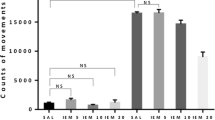Abstract
Riluzole (2-amino-6-trigluoromethoxy benzothiazole) has neuroprotective, anticonvulsant, anxiolytic and anesthetic qualities. These effects are mediated by blockade of glutamate transmission, stabilizing of sodium channels and blockade of γ-aminobutyric acid (GABA) reuptake. The action profile of riluzole is dominated by its effects on glutamate transmission which are predominately mediated by N-methyl-D-aspartate (NMDA) receptor-linked processes in vitro. In vivo studies show that blockade and stimulation of the different NMDA receptor complex binding sites or AMPA receptors modulate motor behavior in a characteristic manner. It was therefore interesting to examine if blockade of glutamatergic transmission by riluzole induced similar behavioral effects as direct NMDA/AMPA receptor antagonists and if these effects are mediated by a specific receptor. The effects of riluzole alone and in combination with several other neuroactive compounds on the central nervous system was assessed by behavioral paradigms to evaluate sniffing behavior, locomotion, ataxia and rigidity. Accompanying compounds included the NMDA receptor agonist NMDA, the partial glycine site agonist D-cycloserine (DCS), and the α-amino-3-hydroxy-5-phenyl-4-isoxazolepropionic acid (AMPA) receptor antagonist GYKI 52466 [1-(4-aminophenyl)-4-methyl-7,8-methylenedioxy-5H-2,3-benzo-diazepine HCl]. Riluzole influenced neither stereotyped sniffing behavior nor locomotion but impaired motor coordination and attenuated rigidity induced by blockade of dopamine D1 and D2 receptor antagonists when given alone. At higher doses spontaneous behavioral activity decreased and motor coordination was more impaired. Augmentation of the riluzole effects were observed when NMDA, but not GYKI 52466, was coadministered. The glycine site agonist DCS increased the anticataleptic properties of riluzole. The results indicate that when given alone, riluzole has a behavioral profile resembling that of competitive NMDA receptor antagonists. However, coadministration of riluzole with NMDA/AMPA receptor ligands suggests that this assumption is incorrect, and that riluzole affects glutamatergic transmission by a more indirect mechanism. Nevertheless, the profile of riluzole together with its pre- and postsynaptic blockade of glutamatergic transmission implies beneficial properties in diseases where an overactive glutamate system induces chronic neurotoxicity and/or acute behavioral effects.
Similar content being viewed by others
Author information
Authors and Affiliations
Additional information
Received: 15 December 1997 / Accepted: 12 May 1998
Rights and permissions
About this article
Cite this article
Kretschmer, B., Kratzer, U. & Schmidt, W. Riluzole, a glutamate release inhibitor, and motor behavior. Naunyn-Schmiedeberg's Arch Pharmacol 358, 181–190 (1998). https://doi.org/10.1007/PL00005241
Issue Date:
DOI: https://doi.org/10.1007/PL00005241




